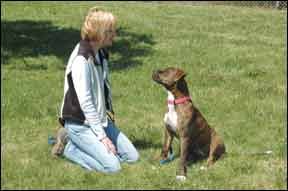Radio talk show psychologist Dr. Joy Browne offers her listeners a stress-reducing “Square Breathing” technique. To relax before or during any potentially anxiety-producing experience, try square breathing: Inhale to the count of four, hold to the count of four, exhale to the count of four, and hold for four. With practice, you can increase each side of the “square” to a count of eight or even 20; the longer the count, the slower and more calming the breathing.
Meanwhile, Karen Overall, VMD, PhD, Diplomate of the American College of Veterinary Behaviorists and director of the veterinary behavior clinic at the University of Pennsylvania for more than 12 years, teaches a similar behavior for stressed canines. Teaching a dog to take a breath works exactly the same way that it does for us. The intake of a deep breath gives both species a chance to take in oxygen and pause long enough for our brains to begin to work instead of react.
(Editor’s note: Dr. Overall talks both about asking the dog to “hold his breath” and to “breathe.” Obviously, he can’t do both at the same time. When he stops panting and closes his mouth, he is “holding his breath.” Then, when you see his nostrils flare, he is breathing. Both help to stop his panting, slow his respiration rate, and decrease his stress.)
According to Dr. Overall:
Dogs, like humans, cannot learn new behaviors if they are distressed. In fact, we all best produce the needed brain chemicals to make lasting memory if we are attentive enough to watch carefully but not so attentive that we are overly concerned. Most dogs about whom clients are concerned and/or who have truly pathological behavior are not calm enough to learn and use new information, especially if part of that information is learning to be calm.
Heart rate, attentiveness, and respiratory rate are all linked. If we can teach a human or a dog to take slower, deeper breaths, they relax, their heart rate decreases, and they can be more attentive to focusing on the task at hand. These responses are all coupled to changes in hormonal and other chemical signals that shift the brain’s and body’s reactivity from a system ready to act on a threat to one ready to focus on learning, not reacting.
The first step for dogs is to teach them to hold their breath as a way to learn deep breathing and focus, as follows:
1. Start to teach the dog to take a deep breath by asking the dog to sit and ‘look’ at you for a food treat held near your eyes.
2. Next, quickly move the treat from your eyes to a point a few inches in front of the dog’s nose, without giving the treat. Say the word ‘breathe.’ Watch carefully here to ensure that the dog remains calm. If the dog becomes more agitated, you will benefit from working with a trained, certified dog trainer or trained veterinary professional who can help you to desensitize the dog to food moving toward his nose.
3. The dog’s nostrils will usually flare as he smells the treat, and because he cannot sniff something and pant at the same time, the dog will hold his or her breath.
4. As soon as you see that the dog has held his breath and/or flared his nostrils, immediately deliver the treat and praise your dog.
5. Practice for a few minutes until you are certain that you know what you are looking for and that your dog is giving it to you. It can be difficult to see nostril flares in dark-faced dogs, but once you learn what a nostril flare looks like on your dog, you will know it.
6. As your dog gets better at responding to the ‘breathe’ request, start to delay the delivery of the treat a few seconds at a time.
7. Within a short while you will have a dog who holds his breath and slows his heart and respiratory rate, and so becomes more focused and relaxed. If you only reward the most focused and relaxed states, your dog will progress nicely.
It does not usually take more than five minutes to teach a dog to hold his or her breath, even if the dog is very hairy or the nose is dark, making the nose tough to see, but it may take longer for you to recognize and encourage the behavior. You will need to be observant and quick, and not linger with presenting the food as an olfactory stimulus.






